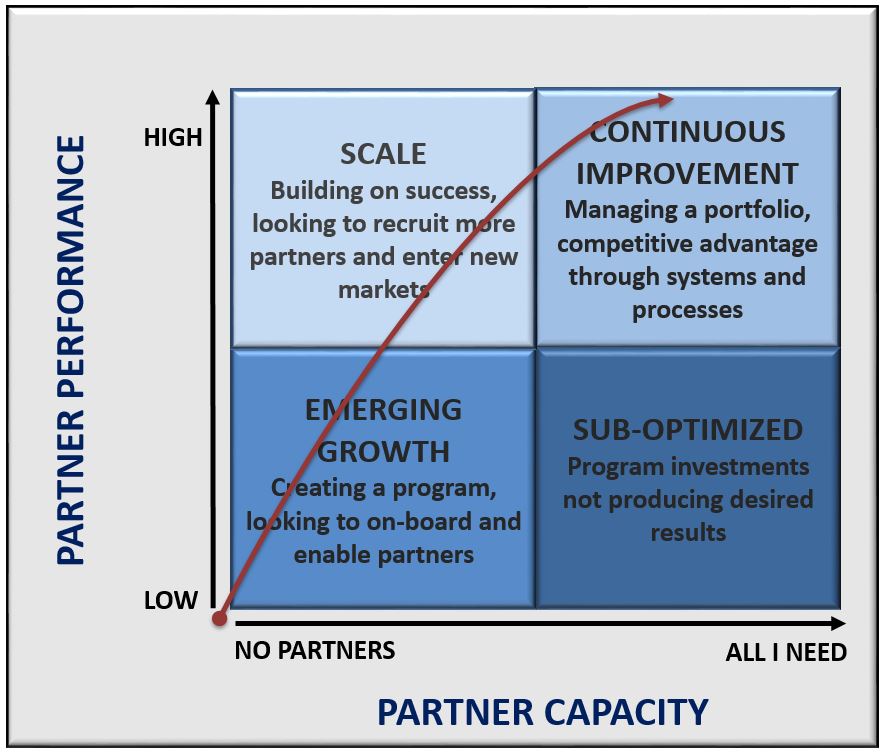As they say, a journey of a thousand miles begins with a single step. Great sales channel ecosystems don't spring up overnight; they require care and attention to cultivate over a period of months and years.
In our 13+ years of working with companies to grow their partner channels, we've noticed that the successful ones all share a fairly similar pattern of growth. Obviously, every company's story is going to be different, but there are definite trends that suggest when an organization is on the right path towards success.
We've broken this down into three basic phases. A company which can successfully pass through these stages without too many missteps is one whose future is looking good.
I. Emerging Growth
Every company has to start somewhere. Companies in the Emerging Growth phase could be new startups or established companies who have decided to implement an indirect sales model. Either way, they're just beginning to grow their partner ecosystem. In this phase, planning is extremely critical.
They generally have two high priority areas of focus. One, of course, is recruiting qualified sales partners. The other is beginning to implement a scalable support system that will allow them to manage those partners in an affordable and accessible way as they keep signing up more of them.
Some common issues a company in the Emerging Growth phase looks to avoid include:
- Haphazardly recruiting any and every partner they can, without regard to future planning, overlap and competition between those partners.
- Lack of communication within the company that prevents them from presenting a unified front to their partners.
- Insufficient content and sales tools to quickly get their partners up to speed
- Over-reliance on ad-hoc software solutions, which can save money at first, but leads to long-term scalability and accessibility issues.
The best way to get through the Emerging Growth phase is to be willing to say "no" to partners and to have a support system and technology solution that allows them to scale the partner program.
II. Scaling
A company has moved into the Scaling phase at the point they have several successful sales partners, a support structure in place for facilitating communications & services for those partners, and a Channel Manager who's successfully balancing the needs of the company and the needs of the partners.
At this point, the focus is on growth - plain and simple. They have a good, stable foundation for their partnership ecosystem. It just needs to keep getting bigger and better. A common pitfall here is to assume that past successes will translate into success going forward. Planning remains a critical component here, especially as it relates to recruiting the right partners that will complement your existing network of partners while also helping you meet your growth objectives.
Some of the common challenges in this phase include:
- Taking a more targeted approach to partner recruitment, based on specific markets, regions, and demographics they wish to add to the ecosystem.
- Leveraging online training solutions, to reduce the cost and time burden of on-boarding new partners while still maintaining quality.
- Improving communications between partners and the Channel Manager, to keep the ecosystem truly manageable. If the Channel Manager starts feeling overwhelmed, it's a bad sign.
- Minimizing channel conflict between a direct sales team and an expanding base of indirect partners.
- Setting up Market Development Funds, either monetary or knowledge-based, which help partners succeed.
- Maintaining internal communication and collaboration, so that departments such as IT, Training, and PR are working together for the benefit of the partners.
Mistakes made in Phase I become major issues in Phase II. However, if the wrinkles can be ironed out, good things continue to happen in Phase II.
III. Continuous Improvement
There's no true "endpoint" to partner ecosystem development. It should continue to grow in sustainable fashion for as long as the top-level vendor is growing. However, growth will ebb and flow somewhat since the larger an organization becomes the more cautious it tends to get about expansion.
In short, it reaches a point of stability and self-sustaining processes which create an inertia that continues propelling the company forward.
Some of the hallmarks of a vendor which has successfully entered Stage III are:
- Most or (hopefully) all sales partners are meeting their goals, year after year.
- Fewer new partners being added, with a greater focus on global partnerships to extend the brand's reach. Partnerships become truly strategic and selective in nature.
- A robust and integrated software suite which allows easy access to and sharing of training, sales data, documentation, and communications between partners and the vendor as well as each other.
- Systems integration with other business-critical platforms like an ERP or POS system.
- Expanded use of rewards programs to keep the top performers highly incentivized.
- A well-expressed and clear roadmap to the future which is shared and understood by the major partners.
- Established pipelines for communicating new product launches and similar large-scale changes to service offerings.
Phase III is where every vendor wants to be, and it's fully obtainable by a business which has made smart decisions throughout earlier Phases.
LogicBay has years of experience helping vendors achieve true partner ecosystem success, enabled by one of the top Partner Relationship Management platforms available. For more help and advice on developing the right plans and processes to reach your long-term goals, check out our Channel Program Blueprint:
